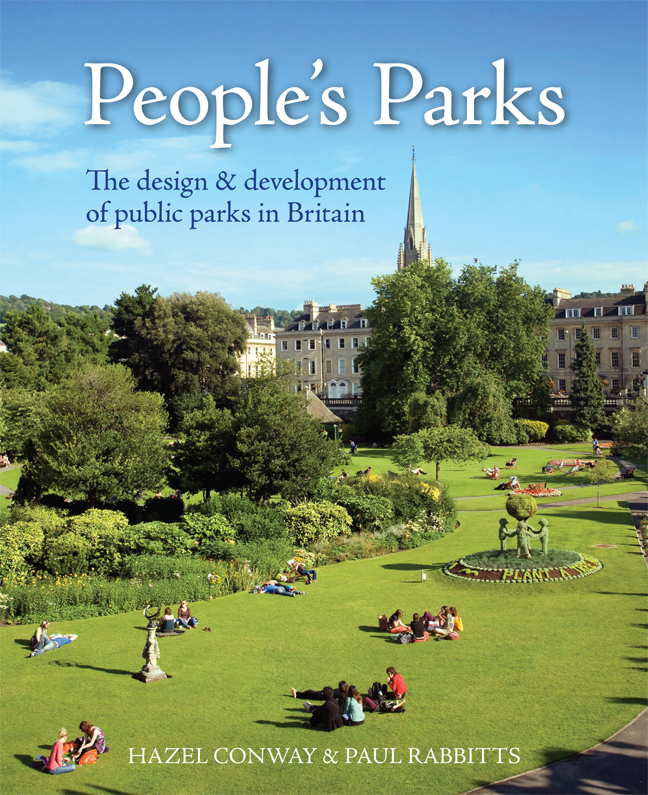Book contents
- Frontmatter
- Dedication
- Contents
- Miscellaneous Frontmatter
- Preface
- Acknowledgements
- Foreword
- A Word from Parks Professionals, Politicians and Parks Organisations
- Introduction: Dr Hazel Conway (1991)
- 1 Public Parks and Municipal Parks
- 2 The Need for Parks
- 3 Pioneering Parks Development
- 4 The Park Movement
- 5 Design and Designers
- 6 Lodges, Bandstands and the Cultivation of Virtue
- 7 Local Pride and Patriotism
- 8 Planting and Park Maintenance
- 9 Permitted Pastimes
- 10 Recreation Grounds, Parks and the Urban Environment
- 11 Public Parks, 1885–1914
- 12 Later Municipal Park Designers
- 13 Garden Cities and the New Towns Movement
- 14 Sport, Physical Activity and Recreation in Public Parks in the Inter-war Years
- 15 Parks Management – a Changing Perspective
- 16 Decline, Revival and Renewal – the Role of Parks into 21st-century Britain
- Appendix 1 Summary of main legislation promoting early park development
- Appendix 2 Chronology of main municipal and public park developments between 1800 and 1885
- Notes
- Bibliography
- Subscription List
- Index
15 - Parks Management – a Changing Perspective
Published online by Cambridge University Press: 22 February 2024
- Frontmatter
- Dedication
- Contents
- Miscellaneous Frontmatter
- Preface
- Acknowledgements
- Foreword
- A Word from Parks Professionals, Politicians and Parks Organisations
- Introduction: Dr Hazel Conway (1991)
- 1 Public Parks and Municipal Parks
- 2 The Need for Parks
- 3 Pioneering Parks Development
- 4 The Park Movement
- 5 Design and Designers
- 6 Lodges, Bandstands and the Cultivation of Virtue
- 7 Local Pride and Patriotism
- 8 Planting and Park Maintenance
- 9 Permitted Pastimes
- 10 Recreation Grounds, Parks and the Urban Environment
- 11 Public Parks, 1885–1914
- 12 Later Municipal Park Designers
- 13 Garden Cities and the New Towns Movement
- 14 Sport, Physical Activity and Recreation in Public Parks in the Inter-war Years
- 15 Parks Management – a Changing Perspective
- 16 Decline, Revival and Renewal – the Role of Parks into 21st-century Britain
- Appendix 1 Summary of main legislation promoting early park development
- Appendix 2 Chronology of main municipal and public park developments between 1800 and 1885
- Notes
- Bibliography
- Subscription List
- Index
Summary
The word ‘keeper’ has been used for centuries in connection with managed green spaces. The Oxford English Dictionary quotes John Heywood's use of the word in 1530, referring to ‘rangers and keepers of certayne places as forests, parkes, purlewes and chasys’, and aligns the word in this context with others signifying a position of primary responsibility, analogous to the Keeper of the Privy Seal. It was a technical and managerial role associated with maintenance of a park and its stock.
With the development of public parks in the mid-19th century the term was adopted to new use. By 1855 ‘park keeper’ could be used merely to signify someone who manned the gates. During the initial period of public park development, the term was used alongside others with various nuances of seniority and responsibility. As W W Pettigrew, parks superintendent in Manchester (1914–32), put it in his 1937 book, Municipal Parks: Layout, Management and Administration:
A considerable divergence exists regarding the recognised designation of certain members of the outside staff employed in public parks in various localities in the British Isles. It is regrettable that this lack of uniformity should exist, as the adoption of a standard denomination would make it so much easier to compare similar classes of work with the remuneration paid for it in all parts of the country.
Divergence between local authorities is nothing new, but this inconsistency, viewed from the early 20th century, also reflects the development of public parks management. There were simply no management models or structures available in the early period: nothing like free public access to high-quality horticulture had ever been attempted before.
The potential difficulties were little understood. Within a month of the opening of Manchester's first three public parks in 1846, the public parks committee was hastily assembling regulations, signage and additional staff, the need for which had not been foreseen. Incredibly, ‘no one had been made responsible for the management of the parks and the necessity for such action seems to have taken the committee by surprise’.
- Type
- Chapter
- Information
- People's ParksThe design & development of public parks in Britain, pp. 249 - 264Publisher: Boydell & BrewerPrint publication year: 2023

